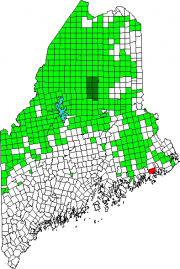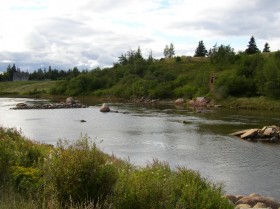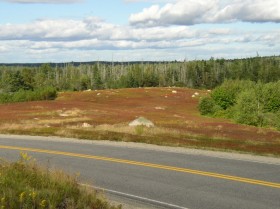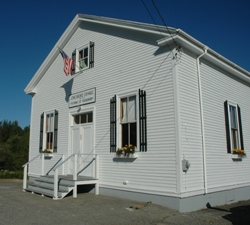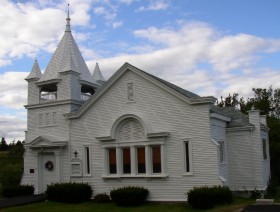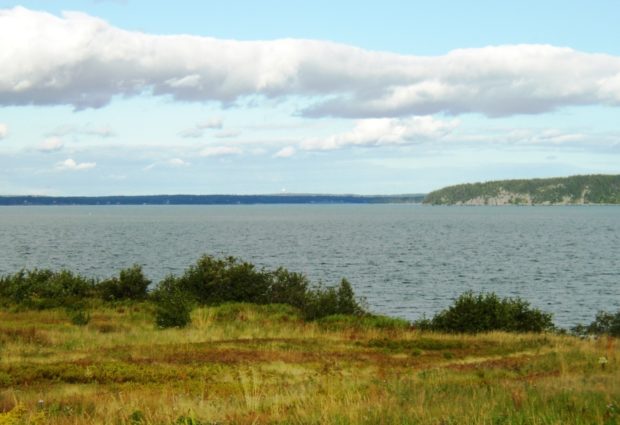
| Year | Population |
|---|---|
| 1970 | 448 |
| 1980 | 553 |
| 1990 | 585 |
| 2000 | 594 |
| 2010 | 583 |
| Geographic Data | |
|---|---|
| N. Latitude | 44:39:58 |
| W. Longitude | 67:34:58 |
| Maine House | District 138 |
| Maine Senate | District 6 |
| Congress | District 2 |
| Area sq. mi. | (total) 38.4 |
| Area sq. mi. | (land) 36.7 |
| Population/sq.mi. | (land) 15.9 |
| County: Washington
Total=land+water; Land=land only |
|
 [JONES-boh-row] is a town in Washington County, incorporated on March 4, 1809.
[JONES-boh-row] is a town in Washington County, incorporated on March 4, 1809.
It had previously been known as Chandler’s River.
This large tract of land was diminished by ceding land to Jones’ Port in 1832, to Columbia and Machias in 1838, and finally to Roque Bluffs in 1891.
Hannah Westin, and her sister, carried 50 pounds of lead through the woods from Jonesboro to Machias to support the effort to capture the British vessel Margaretta in 1775.
The Chandler River, which empties into Englishman Bay, runs through the village.
The area of the photo at right shows evidence of ruins on the shore and in the stream.
The river widens below the village and becomes a major inlet of Englishman Bay.
The first ship to sail to the river in search of trade was captained by a Mr. Locke in 1785.
According to the George Varney in 1886,
Chandler’s River, the principal stream, has two good powers,- “Great Falls,”and “The Mills” at the village at the head of tide. There are now in operation in the town one mill for long lumber and one lath and shingle mill. . . .
Judah Chandler is supposed to have been the first settler. He arrived in 1763 or 1764, building a house and mill in the latter year, near the site of the Whitney mills. Joel Whitney, father of Captain Ephraim Whitney, came from Portland about 1767.
The village is on U.S. Route 1 where it splits to create Route 1A, then both reunite at Machias to the northeast.
Form of Government: Town Meeting-Select Board.
Additional resources
Drisko, George Washington. The Revolution; Life of Hannah Weston, with a brief history of her ancestry. Also a condensed history of the first settlement of Jonesborough, Machias and other neighboring towns. Machias, Me. G. A. Parlin. 1903.
Limeburner, Grace M. Grindle. The Folks of Stuben [sic] Johnsboro [sic] Jonesport and Nearby Towns. North Brooksville, Me. G. Limeburner. 1951-1953?
*Maine. Historic Preservation Commission. Augusta, Me. Text and photos from National Register of Historic Places: http://pdfhost.focus.nps.gov/docs/nrhp/text/xxxxxxxx.PDF and http://pdfhost.focus.nps.gov/docs/nrhp/photos/xxxxxxxx.PDF
Jonesboro Union Church: 02000788.PDF
Jonesboro Grange #357: http://www.maine.gov/tools/whatsnew/index.php?topic=mhpc_recent_listings&id=179074&v=article (accessed August 14, 2015)
The Story of Hannah Weston: and her part in the first naval engagement of the Revolution, June 12, 1775. Machias, Me. The Chapter [Daughters of the American Revolution, Machias]. c1925. (Machias, Me. Union-Republican Press)
Varney, George J. A Gazetteer of the State of Maine. 1886. p. 292.
Whitney, Abel. Boards Surveyed by Abel Whitney. 1809-1816. (Cataloger Note: The collection contains a volume dating from 1809 to 1816 used by Abel Whitney of Jonesboro, Maine. A second volume dating from 1820 to 1822 has the name Joel Whitney, Jonesboro, Me. on the cover. Both volumes record information about lumber transactions, including from whom logs were received and to whom and to which mill they were sent, the owners and types of lumber, etc. The volumes also record transactions involving shipping lumber to various ports and note which vessels were used.) [University of Maine, Raymond H. Fogler Library, Special Collections]
National Register of Historic Places – Listings
Jonesboro Grange #357
The Grange Hall is a 1½ story, wood framed, community center and meeting hall on U.S. Route 1. Typical of many grange buildings, it contains a large meeting room and anteroom on the first floor, a balcony over the vestibule, and dining and kitchen facilities in the basement. The hall was built by Grange members between 1908 and 1910 to serve the local members of the Patrons of Husbandry, an important fraternal organization with roots in 19th century agricultural reform.
It is also a building which has served the community for over 100 years. Aside from the scheduled meetings, the Grange sponsored Fourth of July celebrations, town-wide potluck dinners, dances, concerts and many more activities. The annual lighting of the community Christmas tree and caroling while waiting for the Jonesboro fire truck to transport Santa Claus are long standing events.* [Maine Historic Preservation Commission photo]
Jonesboro Union Church
[Looks Point Road, at junction with US Route 1] On US Route 1, the Jonesboro Union Church overlooks the traffic of residents and tourists in this small, fishing town. As with so many small town churches this one has been at the center of community life since its construction in 1840 and its radical remodeling in 1911.
The first meeting house was built in 1841 on property donated by John Tupper. The main structure consisted of a 26’x35′ rectangular sanctuary, a steeple and a bell tower. Although three churches had been organized in Jonesboro in 1840, by the turn of the 20th century the Baptist and Universalist churches were no longer active. When the only remaining church in town needed substantial repairs it became a community effort, led by the Jonesboro Union Church Aid Society. Additional land was donated, and two years of fundraising and community support followed.
It was decided to raise the building three feet, set it back 20 feet, lay a stone foundation, add a vestry and vestibule and seat the audience across instead of lengthwise of the building, making greater seating capacity. Leander Higgins, a Bar Harbor native, was the architect and the new building was completed in 1911.*


